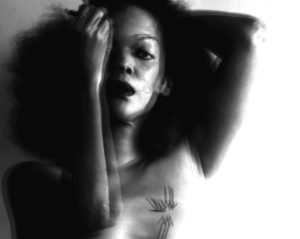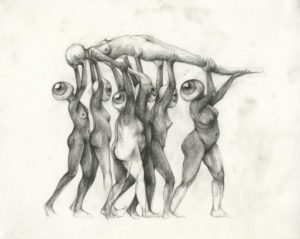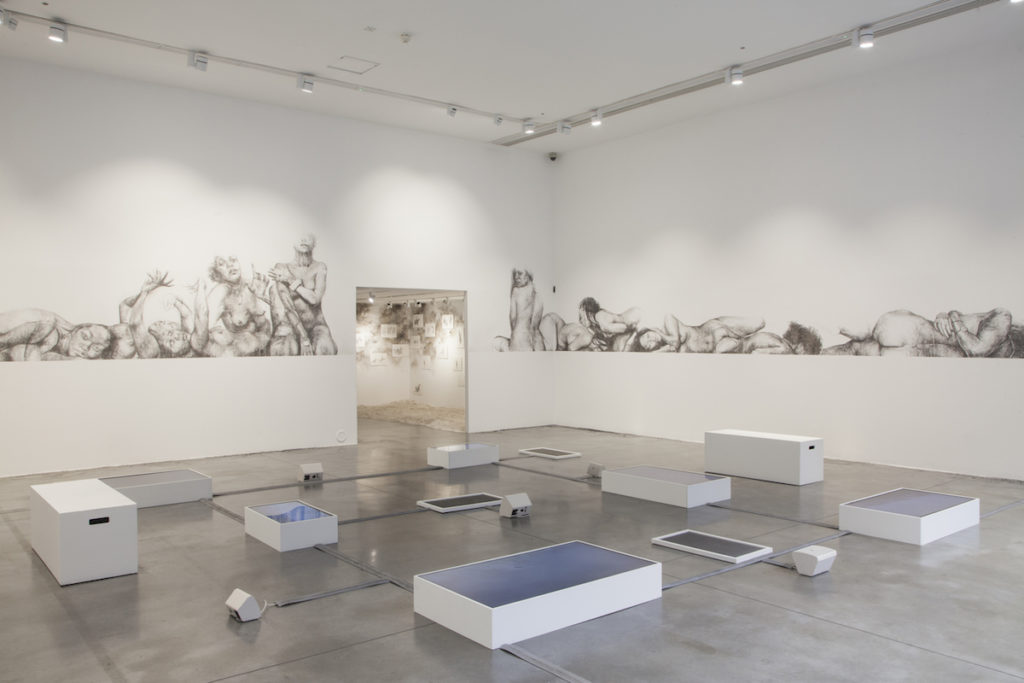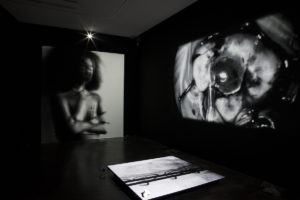
I have connected previously with Phoebe’s work particularly when it has addressed notions of not-belonging, and women’s body as a mean of power, but I must admit, never to at such deep level. Extremely poetic and utterly relatable, Phoebe’s seminal exhibition has meant a place for solace and shared emotions of our most intimate selves.
Raquel Villar-Pérez on the last exhibition of Phoebe Boswell
Phoebe Boswell and the ‘Poetics of Endurance’.
Afterthoughts on ‘The Space Between Things’
For the past ten weeks, Autograph has been home to one of the most visceral and remarkably dolorous, yet intimately relatable and, somehow, life-infusing exhibitions that I have seen in my entire career. Phoebe Boswell’s last body of work gathered under the title The Space Between Things awakened an entire set of emotions ranging from empathy and grief, to admiration, courage, and hope.

Phoebe Boswell, Untitled 2 from the series She Summons an Army, 2018. Courtesy the artist and Sapar Contemporary, New York
I first encountered Boswell’s work when I was being assessed for one of my first jobs working in the African arts arena in London a year after I relocated to the British capital. I was simply asked to design a portfolio with Phoebe’s works. I remember those early works in the artist’s career, The Mechanics of Illusion series. There was something unsettling about them: the unswerving reference to a human being, in this case, like in many, the artist herself, the blurred lines, the distortion, the anguish of feeling as if being permanently in the quest for something, whatever it might be.
I have followed Phoebe’s blossoming ever since; I have trusted her work to the point in which I even put my naked body to serve at her Mutumia’s militia, a project about women’s who use their bodies to protest when they are not permitted to use their voices. The Space Between Things seemed a promising show I wasn’t going to miss.

Phoebe Boswell – The Space Between Things exhibition at Autograph, London, 14 December 2018 – 30 March 2019. Courtesy Autograph.
I entered the exhibition as soon as I approached David Adjaye’s building Rivington Place. The architecture of the building functions as a kind of shop front window, and contrarily to what has been the layout of previous exhibitions, Phoebe’s show didn’t count with a moveable temporary wall covering the space between the privacy of the gallery and the publicly of Rivington street. Instead, it offered a panoramic preview of an immense self-portrait of the artist in overlapping poses that travelled across of the three walls of the main gallery at Autograph, setting an imaginary line of the horizon.
Once inside, I was entranced, not only for the mastery of the drawings, but rather because of the imposing, powerful, and unapologetically raw presence of the artist. The work entitled On the Line absorbed my self, making me feel minuscule. Phoebe was everywhere, looking at me sometimes, not defiantly but rather as kind of reaffirming her self; looking away some other times, contemplative, caring for and nourishing her (wounded) self. In an interview conducted by Debbie Golt, the artist manifested the importance of the use of soft willow charcoal for the mural, since its frailty resonates with that of the human body, which she addressed in the show. Boswell pointed out the non-permanent nature of the piece, and how she trusted the public to take care of it. Listening to her words made me think of our humanity; my trust, and expectancy that we are here to nurture and elevate each other; it made me think of how we continuously fail at it, but above all, of the irremediable hopeful state of knowing deep inside me how much we can succeed at it.

Phoebe Boswell, 16) Phoebe Boswell, On The Line [detail], 2018 [detail], 2018. Courtesy Autograph.
Phoebe’s art practice crosses over between traditional drawing, and interactive technologies in which the audience participates in signifying the piece. Indeed, accompanying her multi-layered portrait there were a series of floor-mounted TV screens distributed across the gallery presenting different scenes of her work Ythlaf. The footage displayed the artist being sweetly swayed adrift by the seawaters. A number of sensor pads that were activated by having people standing on them and released spoken word works, completed the interactive installation.

Phoebe Boswell, film still from Ythlaf. Single channel Video, 2018. Courtesy the artist and Sapar Contemporary, New York
She Summons an Army was the next piece as I moved through the exhibition. It consisted of a series of drawings on paper depicting naked women with eye-shaped heads captured in playful motion but above all, performing acts of support and care for each other. Sistren-hood and the use of the woman’s naked body as a means of power are both re-occurring themes in Phoebe’s work.

Phoebe Boswell, Untitled 15 from the series She Summons an Army, 2018. Courtesy the artist and Sapar Contemporary, New York
The exhibition continued upstairs; if so far feelings of live-affirmation, self-reassurance, camaraderie, and care stemmed from the show, in this second part of it, Phoebe’s pain and sorrowfulness spread all over your deepest self, and heart, encroaching them. The dark and small room functions as a space where the traumatic experiences are exposed; that is the moment of physical and emotional rupture, the genesis of The Space Between Things.
A black and white video showing what looks like the surgery of an eye presides the room. The footage corresponds to one of the many surgeries the artist had to undergo in order to save her right eye after an unfortunate accident at home. In the video, the surgeons are implanting donors’ cells behind Phoebe’s cornea in order to fortify it. The video is modified digitally to make the blood seem ink in reference to drawing, distinctively, the main medium used by Phoebe. On the floor there is the visualisation of an angiogram showing the artist’s broken heart, which occurred only three weeks after the accident in her eye. On the left, her video-work Rapture. I learnt later, it was the undecipherable sound of the artist’s voice what filled up the space; like breathing.

Phoebe Boswell, film still from Rapture [detail], 2018. Single channel video. Courtesy the artist and Sapar Contemporary, New York.
In the last days of the show, I had the great opportunity to encounter Renée Musai online, Senior Curator and Head of Curatorial, Archive & Research at Autograph, who generously shared with me her thoughts on how the show had come about. She informed me that they “had been following Phoebe’s remarkable practice for several years, and had been talking internally about presenting her work at the gallery for a while” so after a number of studio visits and in depth conversations between Phoebe and herself, they offered Phoebe to present her work in progress at Autograph occupying the two gallery spaces in early 2018. Renée referred to it as “a profound and courageous body of work that constitutes an emotive – personal yet universal, too – interrogation of trauma, the fragility of the body and what I describe as the ‘poetics of endurance’ – it’s also, crucially, an affirmation of resilience, healing and survival. Deeply poetic, beautiful and profound – one of the most honest, courageous and generous artistic endeavours I have had the privilege to be involved in during many years working as a curator. The idea was for Phoebe to inscribe herself, her story, her being into the very skin of the gallery walls, mark-making in its purest form, if you will – raw and transient – thus the commissioning element became a temporary 25m wall extended portrait of the self, her largest site specific drawing to date.”

Phoebe Boswell – The Space Between Things exhibition at Autograph, London, 14 December 2018 – 30 March 2019. Courtesy Autograph.
As a junior curator, I have followed Renée’s career for several years now. I admire her sensibility, the love, and care put into each show that opens at Autograph, also the scholarship that stems from them, as they are deeply thought-provoking, moving, and very pertinent to the contemporary art discourses within the Global. Bearing in mind that every exhibition has its particularities that makes it special, I also wanted to know what it had meant for Renée to curate such a visceral and almost redemption-like exhibition that was Phoebe’s show and also for Autograph: “Curating Phoebe’s exhibition and working closely with her has been a real privilege, and without doubt a life-affirming and a profoundly touching experience curatorially. When I first visited Phoebe’s studio, and she so generously shared her story and current work, I knew that this project would require us both to be open and flexible about approach and ultimately, presentation – it became a very organic and intimate process, one that required a large degree of trust and commitment on both sides. I try to advocate for black women’s practices as much as possible in my curatorial work … and I’ve long admired Phoebe’s immense talent: she is, in my view, without doubt, one of the most remarkable and important contemporary artists working in Britain (and beyond) today – the collaboration has been profoundly rewarding both personally and professionally: an incredible artist, and human being. And for Autograph as an organisation, enriching and transgressive – in terms of medium as well as subject matter – part of a series of new chapters to come which I hope will offer new openings, new beginnings, new explorations with brilliant contemporary interdisciplinary practitioners such as Phoebe Boswell.”

Phoebe Boswell – The Space Between Things exhibition at Autograph, London, 14 December 2018 – 30 March 2019. Courtesy Autograph.
After observing the drawings of the sea with it’s the different tempers and moods, that escorted the room of trauma, I lead myself back downstairs to the main gallery. What a beautiful realisation was to notice tiny photographs of the Phoebe and her family at different stages of her life, attached to the walls of the staircase; those who were by her side during some of the darkes.t moments of her life. Are those ‘spaces in between things’ occupied by our most beloved ones? Aren’t they who hold our hand through our processes of healing and celebrate with us our catharsis?
Back to the main gallery I let myself be nested by Phoebe’s redemption again. I realised that the images of the artist floating, are images of her healing process back to her family home in Zanzibar. I connected the therapeutic use of her Indian Ocean, to the emotional healing power of the Mediterranean Sea when I am back home, the idea of trauma that we all carry upon ourselves, our link to our most beloved ones: my parents, my sister, that are also away… I have connected previously with Phoebe’s work particularly when it has addressed notions of not-belonging, and women’s body as a mean of power, but I must admit, never to at such deep level. Extremely poetic and utterly relatable, Phoebe’s seminal exhibition has meant a place for solace and shared emotions of our most intimate selves.
Phoebe Boswell
Born in Nairobi to a Kikuyu mother and British Kenyan father, and raised in the Arabian Gulf, Phoebe Boswell (b. 1982) is a multi-disciplinary artist who lives and works in London.
Boswell studied at the Slade School of Art and Central St Martins. She is currently a Somerset House artist-in-residence, a Ford Foundation Fellow, and is represented in the United States by Sapar Contemporary, New York.
Her work has been widely exhibited: with galleries Sapar Gallery, Carroll / Fletcher, and Tiwani Contemporary; art fairs including Art15, 1:54, and Expo Chicago; and has screened at Sundance, the London Film Festival, LA Film Festival, Blackstar, Underwire, British Animation Awards, and CinemAfrica amongst others.
She participated in the Gothenburg International Biennial of Contemporary Art 2015 and was commissioned to make new work for the Biennial of Moving Images 2016 at the Centre d’Art Contemporain in Geneva.
Boswell was the first recipient of the Sky Academy Arts Scholarship, was awarded the Special Prize at the Future Generation Art Prize for her interactive installation Mutumia, which consequently showed as part of the 57th Venice Biennale, and has recently been awarded the Bridget Riley Drawing Fellowship at the British School of Rome. An international solo show of her work will open in February 2019 at the Goteborg Konsthalle, Sweden.
